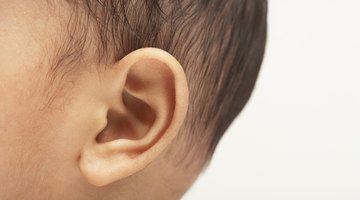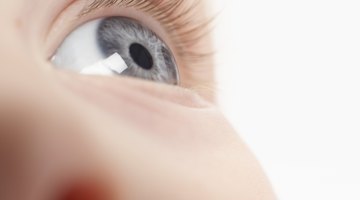Signs of Blindness in Newborns
A newborn's eyes are not fully developed, according to Lawrence M. Kaufman, M.D., Ph.D. at the University of Illinois Medical Center. The elements of the eyes develop in utero, but the nerve and internal structures continue to grow over the first two years of life.
This means a newborn will not have sharp vision, making it difficult to determine if your child has a problem that will lead to blindness. There are some key indicators, however.
Physical Signs
Although a baby's eyes are only 75 percent developed at birth, you should not see any physical deformity. In other words, the eyes will look quite normal. The eyelids should not drop or swell. There should be clear color definition, a white space and distinct pupil.
The pupils of both eyes should act together and face front as you talk to your baby. One eye turning slightly in or out is a sign of a problem.
Symptoms of Illness

What Are the First Signs of Lazy Eye in Infants?
Learn More
Drainage that goes beyond the usual tears may be a sign of an eye disease or infection. Yellow or thick discharge coming out of either eye requires medical evaluation. Eyes that develop a crusty edge or that are difficult to open may be infected. Conjunctivitis is inflammation of the white portion of the eye probably due to bacterial infection. Some babies pick up an infection as they pass through the birth canal, reports the University of Illinois Medical Center. Untreated infections can lead to permanent vision loss.
Focus
Focus is not a reliable indicator of vision at birth, but as your infant grows, it should tell you something. Age three months is when the baby's eyes should start following objects as they move. The inability to focus on visual stimuli is known as visual inattention. Delayed development of the structures of the eyes may be the culprit. For some babies, this lack of focus can indicate eye disease and potential vision loss.
The Little Things

Puffy Eyes in Babies
Learn More
Ultimately, it is the little things that will probably tip you off, such as excessive tearing whether your baby is crying or not, or squinting as he attempts to focus on your face. His head may tilt to the left or right when he looks at a toy or mobile, indicating he sees better in one eye. He might turn his head away from light or close his eyes in sunlight.
You may see a spot in one eye every time you look at a picture of your baby. If anything seems off, have your pediatrician check the infant's eyesight.











